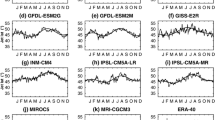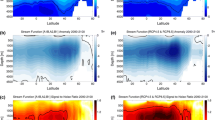Abstract
The anthropogenic changes during boreal winter in the thermal and zonal flow structure over Eastern Atlantic and Western Europe (EAWE) have been investigated using an ensemble of CMIP3 and CMIP5 models. The ensemble mean change in the zonal wind at 500 hPa over this region is characterized by an eastward extension of the belt of zonal winds. Using the thermal wind relation these wind changes are found to be consistent with the changes in the tropospheric temperature profile. An enhanced warming is simulated in the subtropical upper troposphere and a relative surface cooling in the mid-latitudes. The subtropical upper tropospheric warming is related to the downward branch of the mean meridional circulation, whereas the mid-latitude lower tropospheric relative cooling is linked to the ocean processes that govern changes in its surface temperatures. Inter-model differences in the simulated change of the zonal wind over the EAWE by the CMIP3 and CMIP5 models relate well with differences in the upper tropospheric subtropical warming and the mid-latitude lower tropospheric relative cooling. The simulated change of the zonal wind over the EAWE region by the CMIP3 and CMIP5 models correlates well with changes in the meridional SST gradient. We conclude that uncertainties in the projected changes of the zonal flow over Europe are at least partly due to uncertainties in the response of the North Atlantic Ocean to increased levels of greenhouse gases.







Similar content being viewed by others
References
Allen RJ, Sherwood SC (2008) Warming in the upper tropical troposphere deduced from thermal winds. Nat Geosci 1:399–403
Bretherton CS, Battisti DS (2000) An interpretation of the results from atmospheric circulation models forced by the time history of observed sea surface temperature distribution. Geophys Res Lett 27:767–770
Chen G, Lu J, Sun L (2013) Delineating the eddy-zonal flow interaction in the atmospheric circulation response to climate forcing: uniform SST warming in an idealized aqua-planet model. J Atmos Sci. doi:10.1175/JAS-D-12-0248.1
Drijfout S, van Oldenborgh GJ, Climatoribus A (2012) Is a decline of AMOC causing the warming hole above the North Atlantic in observed and modeled warming patterns? J Clim 25:8373–8379. doi:10.1175/JCLI-D-12-00490.1
Haarsma RJ, Selten FM (2012) Anthropogenic changes in the Walker circulation and their impact on the extra-tropical planetary wave structure in the Northern Hemisphere. Clim Dyn. doi:10.1007/s00382-012-1308-1
Hazeleger W, Severijns C, Semmler T, Stefanescu S, Yang S, Wang X, Wyser K, Dutra E, Bintanja R, van den Hurk B, van Noije T, Selten F, Sterl A (2010) EC-earth: a seamless earth-system prediction approach in action. Bull Am Meteorol Soc 91:1357–1363
Intergovernmental Panel on Climate Change (IPCC) (2007) Global climate projections. In: Solomon S et al (eds) The physical science basis, chap 10. Cambridge University Press, Cambridge
Kok CJ, Opsteegh JD (1985) Possible causes of anomalies in seasonal mean circulation patterns during the 1982–83 El Niño event. J Atmos Sci 42:677–694
Lau N-C, Holopainen EO (1984) Transient eddy forcing of the time-mean flow as identified by geopotential tendencies. J Atmos Sci 41:313–328
Lau N-C, Tennekes H, Wallace JM (1978) Maintenance of the momentum flux by transient eddies in the upper troposphere. J Atmos Sci 35:139–146
Lorenz DJ, DeWeaver ET (2007) Tropopause height and zonal wind response to global warming in the IPCC scenario integrations. J Geophys Res 112:D10119. doi:10.1029/2006JD008087
Lu J, Vecchi GA, Reichler T (2007) Expansion of the Hadley cell under global warming. Geophys Res Lett 34:L06805. doi:10.1029/2006GL028443
Lu J, Deser C, Reichler T (2009) Cause of the widening of the tropical belt since 1958. Geophys Res Lett 36:L03803. doi:10.1029/2008GL036076
Ma J, Xie S-P, Kosaka Y (2012) Mechanisms for tropical tropospheric circulation change in response to global warming. J Clim 25:2979–2994
Meehl G, Covey C, Delworth T, Latif M, McAveney B, Mitchell J, Stouffer R, Taylor K (2007) The WCRP CMIP3 multi-model dataset. Bull Am Meteorol Soc 88:1383–1394
Opsteegh JD, Vernekar AD (1982) A simulation of the January standing wave pattern including the effects of transient eddies. J Atmos Sci 39:734–744
Rotstayn LD, Collier MA, Jeffrey SJ, Kidston J, Syktus JI, Wong KK (2013) Anthropogenic effects on the subtropical jet in the Southern Hemisphere: aerosols versus long-lived greenhouse gases. Environ Res Lett 8:014030. doi:10.1088/1748-9326/8/1/014030
Schneider T, O’Gorman PA, Levine XJ (2010) Water vapor and the dynamics of climate changes. Rev Geophys 48:RG3001. doi:10.1029/2009RG000302
Seidel DJ, Fu Q, Randel WJ, Reichler TJ (2008) Widening of the tropical belt in a changing climate. Nat Geosci 1:21–24
Stephenson DB, Held IM (1993) GCM response of northern winter stationary waves and storm tracks to increasing amounts of carbon dioxide. J Clim 6:1859–1870
Sterl A, Severijns C, Dijkstra H, Hazeleger W, van Oldenborgh GJ, van den Broeke M, Burgers G, van den Hurk B, van Leeuwen PJ, van Velthoven P (2008) When can we expect extremely high surface temperatures? Geophys Res Lett 35:L14703. doi:10.1029/2008GL034071
Taylor KE, Stouffer RJ, Meehl GA (2012) An overview of CMIP5 and the experimental design. Bull Am Meteorol Soc 93:485–498
Titchner HA, Thorne PW, McCarthy MP, Tett SBF, Haimberger L, Parker DE (2009) Critically reassessing tropospheric temperature trends from radiosondes using realistic validation experiments. J Clim 22:465–485. doi:10.1175/2008JCLI2419.1
Ulbrich U, Pinto JG, Kupfer H, Leckebusch GC, Spangehl T, Reyers M (2008) Changing Northern Hemisphere storm tracks in an ensemble of IPCC climate change simulations. J Clim 21:1669–1679
Van den Hurk BJJM, Klein Tank AMG, Lenderink G, van Ulden A, van Oldenborh GJ, Katsman C, van den Brink H, Keller F, Bessembinder J, Burgers G, Komen G, Hazeleger W, Drijfhout SS (2007) New climate scenarios for the Netherlands. Water Sci Technol 56:27–33. doi:10.2166/wst.2007.533
Van Ulden AP, van Oldenborgh GJ (2006) Large-scale atmospheric circulation biases and changes in global climate model simulations and their importance for climate change in Central Europe. Atmos Chem Phys 6:863–881
van Vuuren DP, Edmonds J, Kainuma M, Riahi K, Thomson A, Hibbard K, Hurtt GC, Kram T, Krey V, Lamarque JF, Masui T, Meinshausen M, Nakicenovi N, Smith SJ, Rose SK (2011) The representative concentration pathways: an overview. Clim Change 109:5–31
Woollings T (2008) Vertical structure of anthropogenic zonal-mean atmospheric circulation change. Geophys Res Lett 35:L19702. doi:10.1029/2008GL034883
Woollings T, Blackburn M (2012) The North Atlantic jet stream under climate change and its relation to the NAO and EA patterns. J Clim 25:886–902
Woollings T, Gregory JM, Pinto JG, Reyers M, Brayshaw DJ (2012) Response of the North Atlantic storm track to climate change shaped by ocean–atmosphere coupling. Nat Geosci 5:313–317. doi:10.1038/ngeo1438
Yin JH (2005) A consistent poleward shift of the storm tracks in simulations of 21st century climate. Geophys Res Lett 32:L18701. doi:10.1029/2005GL023684
Author information
Authors and Affiliations
Corresponding author
Rights and permissions
About this article
Cite this article
Haarsma, R.J., Selten, F. & van Oldenborgh, G.J. Anthropogenic changes of the thermal and zonal flow structure over Western Europe and Eastern North Atlantic in CMIP3 and CMIP5 models. Clim Dyn 41, 2577–2588 (2013). https://doi.org/10.1007/s00382-013-1734-8
Received:
Accepted:
Published:
Issue Date:
DOI: https://doi.org/10.1007/s00382-013-1734-8




